Here’s an astonishing fact about U.S. bike-shares: In seven years and some 23 million rides, not a single death has been tied to the programs.
That sparkling safety record, reported by Reuters this week, is all the more mind-boggling when you consider the people who use bike-shares. In addition to serious riders, you have novices and tourists—all of whom have to navigate through pedestrians and rush-hour traffic and horrifically crowded places like Times Square, often for the very first time. But we learned in May that New York’s Citi Bike program was fatality-free through its first year of operation, and now that statistic is being extended to bike-shares across the country.
It might seem natural to fear that adding cyclists to busy city streets will increase serious accidents and injuries. But urban planning and public safety experts have long believed just the opposite. They call it the “safety in numbers” effect—the more people you put on bikes, the safer they become.
In 2003, public health consultant Peter Lyndon Jacobsen documented this phenomenon in the journal Injury Prevention. “Research at specific sites has shown that collisions between a motorist and a person walking or bicycling diminish where more people walk and bicycle,” he wrote. Earlier analysis showed that accidents per cyclist fell sharply as the number of bike riders in an area rose past 50 per hour. Jacobsen theorized that increased presence of cyclists put them on motorists’ radars and thereby forced them to drive more safely. More than 10 years later, Jacobsen’s theory is widely agreed upon by bike-sharing advocates.
Cyclists are now so common that urban pedestrians will often tell you they are now more worried about getting hit by a bike than a car. (As a New York City resident, I can add that this is a perfectly reasonable concern.) Yesterday, the New York Police Department announced the two-week initiative Operation Safe Cycle, focused on ticketing cyclists who violate the rules of the road: riding against traffic, running red lights, and failing to yield to pedestrians. (The NYC blog Gothamist nodded to the historically tense relationship between cyclists and New York cops by publishing one example of a commonplace image: an NYPD vehicle parked in a bike lane.)
“Drivers and cyclists tend to speak in mutually exclusive terms,” says Nick Bohnenkamp, executive director of the Denver B-cycle sharing program. “Many of us fall into both of these categories, but at any one time we are just in one of them. Bike-sharing is helping people get out of the driver category and into the cyclist one more often.” Should that remain the case, hopefully we can look forward to another seven years or 23 million rides with zero fatalities—whichever takes longer.
